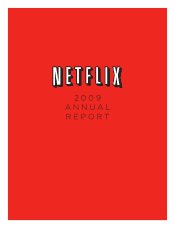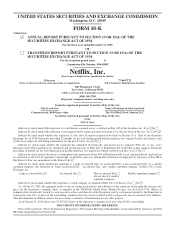NetFlix 2009 Annual Report Download - page 9
Download and view the complete annual report
Please find page 9 of the 2009 NetFlix annual report below. You can navigate through the pages in the report by either clicking on the pages listed below, or by using the keyword search tool below to find specific information within the annual report.easily shift spending from one provider to another. For example, consumers may subscribe to cable, rent a DVD
from Redbox or Blockbuster, buy a DVD from Wal-Mart or Amazon, download a movie from Apple iTunes,
watch a TV show on Hulu.com, and subscribe to Netflix, or some combination thereof, all in the same month.
New competitors may be able to launch new businesses at a relatively low cost. DVDs and Internet delivery of
content represent only two of many existing and potential new technologies for viewing entertainment video. In
addition, the growth in adoption of DVD and Internet delivery of content is not mutually exclusive from the
growth of other technologies.
Our principal competitors include:
• DVD rental outlets and kiosk services, such as Blockbuster, Movie Gallery and Redbox;
• video package providers with pay-per-view and VOD content including cable providers, such as Time
Warner and Comcast; direct broadcast satellite providers, such as DIRECTV and Echostar; and
telecommunication providers such as AT&T and Verizon;
• online DVD subscription rental web sites, such as Blockbuster Online;
• entertainment video retail stores, such as Best Buy, Wal-Mart and Amazon.com; and
• Internet movie and TV content providers, such as Apple’s iTunes, Amazon.com, Hulu.com and Google’s
YouTube.
Studio licensing and movie distribution
Motion pictures, including movies and TV episodes (“entertainment video”) are distributed broadly through
a variety of channels, including movie theaters, airlines, hotels and in-home. In-home distribution channels
include DVD rental, retail outlets and web sites, Internet delivery and cable, satellite and telecommunication
providers offering basic and premium TV, pay-per-view and VOD. Currently, studios distribute movies
approximately three to six months after theatrical release to the home video market, three to seven months after
theatrical release to pay-per-view and VOD, one year after theatrical release to premium TV and two to three
years after theatrical release to basic cable and network TV. Internet delivered content is made available typically
at the same time as pay-per-view or VOD. However, some content, such as TV episodes, are often made
available for Internet viewing shortly after the original airing date. The major studios and TV networks have
continued to experiment with shortened release windows, and we anticipate that they will continue to test a
variety of modifications or adjustments to the traditional windows, including releasing movies simultaneously on
DVD and VOD.
Competitive strengths
We believe that our revenue and subscriber growth are a result of the following competitive strengths:
Iconic brand. Netflix has been highly rated in online retail customer satisfaction by independent surveys
from Nielsen Online and in every one of the ten consecutive surveys conducted by ForeSee/FGI Research.
Because of the high level of consumer satisfaction with Netflix, over 90 percent of surveyed subscribers say
that they would recommend the Netflix service to a friend. We believe that these high levels of customer
satisfaction and brand loyalty make it expensive and difficult for competitors to displace Netflix as a
subscription segment leader.
Personalized merchandising. We utilize various tools, including our proprietary recommendation
technology, to create a custom interface for each subscriber. We believe that this customization enhances the
user experience by helping Netflix subscribers discover great movies. Subscribers rate titles through our
service, and our recommendation technology compares these ratings to the database of ratings collected from
our entire user base. For each subscriber, these comparisons are used to make predictions about specific titles
the subscriber may enjoy. These predictions, along with other factors, are used to help merchandise titles to
3






















